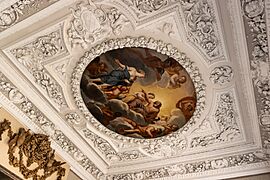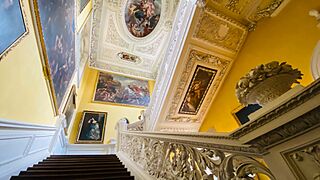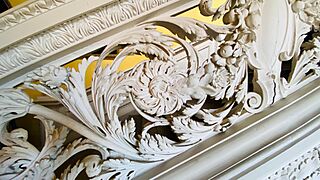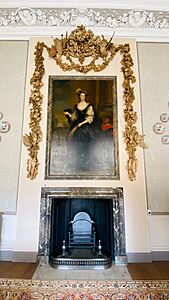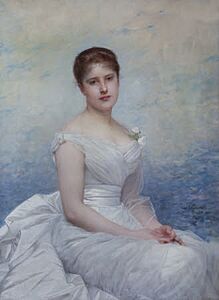Sudbury Hall facts for kids
Quick facts for kids Sudbury Hall |
|
|---|---|
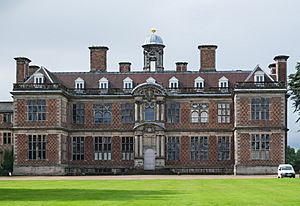
The north-east façade of Sudbury Hall
|
|
| General information | |
| Status | open |
| Type | English country house |
| Architectural style | Restoration-era English Baroque, Jacobean |
| Town or city | Sudbury, Derbyshire |
| Country | United Kingdom |
| Coordinates | 52°53′11″N 1°45′55″W / 52.886338°N 1.765233°W |
| Construction started | 1660 |
| Completed | 1680 |
| Renovated | 1969-1971 |
| Renovating team | |
| Architect | John Beresford Fowler |
Sudbury Hall is a large, beautiful country house located in Sudbury, Derbyshire, England. It is known as one of the best examples of a "Restoration" style mansion in the country. This means it was built around the time King Charles II returned to the throne in England. The house and its gardens are very important, so they are protected as special historical sites.
Inside Sudbury Hall, in a part of the building that used to be for servants, you'll find the National Trust Museum of Childhood.
Contents
A Look at Sudbury Hall's History
In 1086, after the Norman Conquest, Sudbury was listed in the Domesday Book. This was a big survey ordered by William the Conqueror to record land and property in England.
The Vernon family became owners of Sudbury in the 1500s. This happened when Ellen Montgomery, who owned Sudbury, married Sir John Vernon.
Building the Grand House
The Sudbury Hall you see today was built between 1660 and 1680. George Vernon, a member of the Vernon family, built it. He used money he got from marrying a wealthy woman named Margaret Onley. George wanted a grand new home where a smaller house once stood. He kept careful records of all the building costs. Since there's no mention of paying an architect, many historians think George Vernon designed Sudbury Hall himself!
George Vernon also created a village near the Hall. This village provided homes for his servants, workers, and tradespeople. The buildings in this village are still standing today.
Later Years and Changes
From 1840, Queen Adelaide, who was the wife of King William IV, rented Sudbury Hall for three years. Later, between 1876 and 1883, an architect named George Devey added the east wing to the house. By the late 1800s, the Sudbury Estate was very large, stretching across a wide area.
In 1916, George Venables-Vernon, the 8th Baron Vernon, passed away at a young age while serving in World War I. Because of this, the Sudbury estate had to pay a special tax called "death duties." This tax was introduced in 1894 on inherited property. Like many other large estates in Britain, this tax made it hard to keep everything. So, the next owner, Francis Venables-Vernon, the 9th Baron Vernon, had to sell off some land and items from Sudbury Hall. However, in the 1930s and 1940s, he was able to buy back some land to build homes for people in Sudbury village.
During World War II, a hospital for the United States Army Air Forces was set up in Sudbury Park. This land was later bought by the government in 1948 and became HM Prison Sudbury, a prison.
Sudbury Hall and the National Trust
The "death duties" continued to be a challenge for the Vernon family. In 1967, Sudbury Hall, its main contents, and part of its gardens were given to the National Trust. This was a way to help pay off the taxes. The rest of the Sudbury Estate is still owned by the Vernon family's descendants.
In 2020, Sudbury Hall closed for some big changes. The National Trust asked 100 children for their ideas on how to make the house more fun for young visitors. It reopened in October 2022 with a new name: The Children’s Country House at Sudbury. Now, it has areas for dressing up and dancing, a mirror ball, and even an escape room experience! There are also funny speech bubbles next to portraits to help kids learn about the art.
Some members of the Vernon family have said they don't like these changes. They feel the house has become too much like a "theme park" for children. However, the National Trust says these changes offer "new ways for children to learn about the history of Sudbury Hall." They also explain that the speech bubbles help children understand "hidden symbolism in historic portraits." In May 2023, the Children’s Country House at Sudbury won an award for "Permanent Exhibition of the Year." The judges praised its "participatory and imaginative new bold approach" to showing historic houses.
The Design of Sudbury Hall
Sudbury Hall was built in the "Restoration era," but its design also includes features from the earlier "Jacobean" style. You can see this in its fancy Great Staircase and Long Gallery. The house was designed so that the main, grand rooms were on the west side, and the servants' rooms were on the east. This was a common layout for houses built in earlier times. Some historians think the design might have been inspired by Crewe Hall in Cheshire.
The house is made of red brick and has two floors. The main entrance has a grand "Baroque" style porch with two levels of columns and decorative carvings. These carvings were made by a sculptor named William Wilson.
Inside Sudbury Hall
The inside of the house was finished in 1691. There have been a few small changes over the years, and the interior was carefully restored between 1969 and 1971.
The Great Staircase, designed by Edward Pierce around 1676, is one of the most famous "Restoration" staircases in Britain. It has beautiful white-painted railings with detailed carvings of leaves and plants. The ceiling above the landing has amazing plasterwork by Robert Bradbury and James Pettifer, and paintings of old stories by Louis Laguerre. Other plasterwork in the house was also done by Pettifer, Bradbury, and Samuel Mansfield. In the drawing room, there's a very special carved fireplace decoration called an overmantel by Grinling Gibbons.
Between 1872 and 1880, architect George Devey made big changes to the east wing of Sudbury Hall. This part of the house now holds the National Trust Museum of Childhood.
- Architecture of Sudbury Hall
Art Collection at Sudbury Hall
Sudbury Hall has a large collection of paintings, especially portraits of members of the Vernon family. There are also other beautiful artworks. One important painting is a portrait of George Vernon (who built the Hall) by John Michael Wright, painted in 1660.
Other interesting portraits include:
- Catherine Vernon (1663-1710), one of George Vernon's wives, painted by John Riley in 1681.
- Edward Venables-Vernon-Harcourt, who was the Archbishop of York, painted by Sir Thomas Lawrence in 1823.
- Two famous women connected to King Charles II: Nell Gwyn by Sir Peter Lely (around 1675), and Louise de Kérouaille, Duchess of Portsmouth, thought to be by Sir Godfrey Kneller (1670).
- A pair of portraits of King George III and Queen Charlotte of Mecklenburg-Strelitz from the studio of Sir Joshua Reynolds, painted in 1779.
- Art treasures of Sudbury Hall
-
Edward Venables-Vernon-Harcourt, Archbishop of York, by Sir Thomas Lawrence (1823)
-
The Hon. Anne Howard, Lady Yonge (d.1775) by John Vanderbank (1737); overmantel by Grinling Gibbons
-
Overmantel by Grinling Gibbons (detail)
-
Louise de Kérouaille, Duchess of Portsmouth, attr. Sir Godfrey Kneller (1670) with National Trust speech bubble
-
Frances Margaret Lawrance, Lady Vernon by Jules Joseph Lefebvre (1883)
Sudbury Hall on Screen
Sudbury Hall has been used as a location for filming!
- The inside of the house was used for scenes of Pemberley in the 1995 BBC TV show of Jane Austen's Pride and Prejudice.
- The house's unique domed roof was shown in the opening credits of a children's TV show called The Book Tower.
See also
- Catherine Pegge
- George John Venables-Vernon, 5th Baron Vernon
- Grade I listed buildings in Derbyshire
- Listed buildings in Sudbury, Derbyshire



